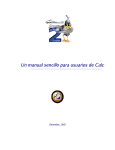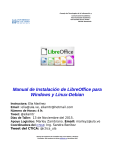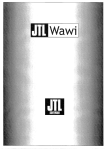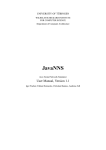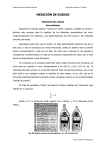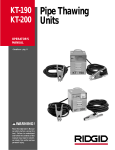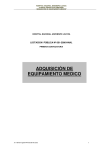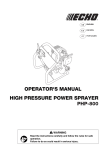Download Manual de Instalacion de OpenOffice.org
Transcript
Manual de Instalación para OpenOffice.org CARRERO LEÓN, Joskally C. Junio, 2005 Manual de Instalación para OpenOOfice.org Licencia de uso Este manual contiene un tutorial y un cúmulo de información referencial sobre los procesos de obtención e instalación de la suite de ofimática OpenOffice.org. Copyright (c) 2005 Joskally C. Carrero León. (CecalULA. Universidad de Los Andes. Venezuela) Se concede permiso de copiar, distribuir o modificar este documento bajo los términos establecidos por la licencia de documentación de GNU, GFDL, Versión 1.2 publicada por la Free Software Foundation en los Estados Unidos, siempre que se coloquen secciones sin cambios o nuevos textos de portada o nuevos textos de cubierta final. Una copia de la licencia se incluye al final del documento en el capítulo “GNU Free Documentation License”. Me apegaré a esta licencia siempre que no contradiga los términos establecidos en la legislación correspondiente de la República Bolivariana de Venezuela. Según establece GFDL, se permite a cualquier modificar y redistribuir este material y el autor original confía que otros crean apropiado y provechoso hacerlo. Esto incluye traducciones, bien a otros lenguajes naturales o a otros medios electrónicos o no. A mi entender de GFDL, cualquiera puede extraer fragmentos de este texto y usarlos en un nuevo documento, siempre que el nuevo documento se acoja también a GFDL y sólo si mantienen los créditos correspondiente al autor original (tal como lo establece la licencia). 3 Manual de Instalación para OpenOOfice.org Licensing This handbook contains both tutorial and reference information on the obtaining processes and installation of the office suite OpenOffice.org. Copyright (c) Joskally C. Carrero León. (CecalULA. Universidad de Los Andes. Venezuela) Permission is granted to copy, distribute and/or modify this document under the terms of the GNU Free Documentation License, Version 1.2 or any later version published by the Free Software Foundation; with no Invariant Sections, no Front-Cover Texts, and no Back-Cover Texts. A copy of the license is included in the section entitled "GNU Free Documentation License". Under the terms of the GFDL, anyone is allowed to modify and redistribute this material, and it is our hope that others will find it useful to do so. That includes translations, either to other natural languages, or to other computer source or output formats. In my interpretation of the GFDL, you may also extract text from this book for use in a new document, as long as the new document is also under the GFDL, and as long as proper credit is given (as provided for in license) 4 Manual de Instalación para OpenOOfice.org Tabla de Contenido: Capitulo 1 CONOCIENDO AL OPENOFFICE.ORG Pagina • ¿Qué es OpenOffice.org? 7 • ¿Por qué utilizar OpenOffice.org? 7 • Programas que integran esta Suite de Ofimática 8 • Abriendo OpenOffice.org 8 • Conociendo el entorno de trabajo del OpenOffice.org 9 • Cómo usar la ayuda del OpenOffice.org 9 • Cerrando OpenOffice.org 12 Capitulo 2 OBTENER, INSTALAR Y CONFIGURAR AL OPENOFFICE.ORG Obteniendo al OpenOffice.org • Cuáles son las maneras de obtener al OpenOffice.org 15 • Cómo descargarlo desde Internet 15 • Cómo descargarlo desde el FTP 16 • Cómo descargarlo desde el CD 16 Requerimientos mínimos para los Sistemas Operativos • Cuáles son los requerimientos que exige OpenOffice.org par ser instalado en el Sistema Operativo Linux 16 • Cuáles son los requerimientos que exige OpenOffice.org par ser instalado en el Sistema Operativo Windows 16 Instalando el OpenOffice.org • 17 Cómo realizar el proceso de instalación Instalando el Diccionario para la corrección ortográfica • Cómo instalar el Diccionario 22 Configurando al OpenOffice.org • Cómo adaptar el diccionario de acuerdo a los requerimientos particulares del usuario 23 Referencias Bibliográficas 27 GNU Free Documentation License 28 5 Manual de Instalación para OpenOOfice.org 6 Capitulo I: Conociendo al OpenOffice.org “Quienes nunca se arriesgan sólo ven los fracasos ajenos” Paulo Coelho Manual de Instalación para OpenOOfice.org Capitulo 1 CONOCIENDO AL OPENOFFICE.ORG Objetivos: • Descubrir en que consiste el OpenOffice.org y cual es la importancia de usarlo, además conocer los elementos que lo definen y como interactuar con ellos, son la esencia de este capítulo. • Definiendo el entorno de desarrollo de la herramienta, para así explicar las utilidades comunes para todos los paquetes de la suite. ¿Qué es openoffice.org? Es un conjunto de herramientas para el trabajo de oficina, por lo que también es conocida como: “Suite de Ofimática”. Esta nace gracias a Sun Microsystems, que decidió publicar el código fuente de su suite Staroffice 5.2, bajo licencia GPL, facilitando su adquisicion desde cualquier medio (Internet, cds, etc) completamente gratis y utilizarlo sin tener problemas, siempre y cuando se conforme a lo previsto por la licencia pública general de GNU, GPL. OpenOffice.org es un producto creado por cientos de personas a nivel mundial que colaboran en conjunto con un fin común: el de permitir que cualquier persona en cualquier parte pueda disfrutar de las ventajas reales que ofrece el uso de Software Libre. ¿Por qué utilizar OpenOffice.org? • Es multiplataforma e independiente del Sistema Operativo (GNU/Linux, Unix, Windows, Macintosh, Solaris), lo que permite usarlo en computadoras muy diferentes sin funciones. • Es libre, se puede descargar gratuitamente de internet, copiar y redistribuir, todo esto de forma completamente legal. • Se puede instalar, reinstalar y obtener actualizaciones completamente gratis, tan solo con visitar la pagina oficial ( http://www.openoffice.org ) • Te hace libre, porque OpenOffice.org tiene su código fuente abierto permitiendo con eso adaptarlo a sus necesidades. • Una vez instalado en el idioma deseado resulta sencillo agregar un diccionario que nos permita hacer uso de la corrección ortográfica usando este idioma y algunos más, porque está disponible en más de 30 lenguajes. • Los archivos de datos se comprimen automáticamente así que requieren menos espacio para ser almacenados, porque el formato para los documentos generados por la suite es código XML comprimido. 9 Manual de Instalación para OpenOOfice.org • Permite la importación y exportación de diferentes tipos de documentos y plantillas de una gran variedad de formatos (desde HTML hasta Microsoft Office XP). • La integración de todas las aplicaciones del sistema de herramientas de oficina, logra un mejor aprovechamiento de las funciones y herramientas que son comunes para todas ellas. Esto quiere decir que no hay necesidad de abrir la aplicación de edición de texto mientras se trabaja en la hoja de cálculo ya que se tiene un acceso directo al mismo. • El parecido entre el entorno de trabajo del OpenOffice.org con otras herramiokkkkentas facilita la adaptación a esta, además de agilizar el proceso de migración a esta herramienta por lo familiar que puede llegar a resultar. Programas que integran este Sistema de Herramientas de Oficina La aplicación esta compuesta de varios paquetes o programas que se pueden acceder de forma individual o bien ser llamadas desde alguna ventana en uso, estos componentes de OpenOffice.org son: • Writer: Es un editor de texto, que permite crear, modificar, dar formato e imprimir documentos. Incluye también un editor HTML y páginas web. • Calc: Es una herramienta para crear hojas de cálculo. Puede integrar fácilmente fórmulas, imágenes y gráficas. Tiene la funcionalidad de generar gráficas en 2D y 3D. Tiene la facilidad de abrir y guardar documentos elaborados en Microsoft Excel. • Impress: Se utiliza para crear efectivas presentaciones multimedia con efectos especiales, animaciones y sonido; en las que se pueden incluir imágenes, textos dibujo, etc. • Draw: Es herramienta para la creación de diseños con la generación automática de líneas, curvas, recuadros, figuras 3-D; utilizando además imágenes vectoriales, dibujos sencillos y formas básicas. Abriendo OpenOffice.org Para iniciar labores con esta herramienta solo son necesarios seguir los siguientes pasos: Manuales de referenciados de esta página son: • Windows: Seleccione Inicio → Programas (o Todos los Programas) →OpenOffice.org 1.1.4, y escoja la aplicación del submenú con la que se quiera trabajar. Por ejemplo, para abrir el procesador de textos (Writer), seleccione documento de texto. • 10 Linux: El procedimiento depende de la distribución de Linux que se tenga, porque cada posee diferentes ambientes de escritorios. Por ejemplo, si usa KDE entonces seleccione K→Oficina y luego escoja la aplicación de OpenOffice con la que trabajará. La mayoría de los ambientes de escritorio de linux tienen una manera relativamente clara y hasta cierto punto intuitiva de encontrar el OpenOffice.org Manual de Instalación para OpenOOfice.org Conociendo el entorno de trabajo del OpenOffice.org Cada una de las aplicaciones de OpenOffice.org poseen características muy particulares que lo definen en cada uno de los entornos de trabajo, de igual forma existen elementos comunes para todo el sistema de herramientas de oficina. Las características que individualizan a cada programa serán explicadas en sus capítulos respectivos, mientras que loas generales se presentaran a continuación: Barra de Funciones Barra de Menú Barra de Herramientas Barra de Objetos Barra de Estado Figura N° 01 Descripción del entorno de trabajo Otras barras de herramientas: • La Barra de hipervínculo para crear y editar hipervínculos en los documentos e introducir criterios de búsqueda en los navegadores de Internet disponibles. • La Barra de fórmulas permite crear e insertar cálculos en un documento de texto. • La Barra de objetos Bézier se muestra al seleccionar un objeto Bézier y pulsar luego modificar puntos. • La Barra de estado contiene información sobre el documento y ofrece varios botones con funciones especiales. El aspecto y funcionalidad de la Barra de estado depende del tipo de objeto que se edite. La Barra de estado se puede configurar con el diálogo Herramientas Configurar. 11 Manual de Instalación para OpenOOfice.org Cómo usar la ayuda del OpenOffice.org Una de las maneras de hacer uso de la ayuda, es invocando a tres elementos muy útiles como lo son: el Ayudante, la Ayuda emergente y la Ayuda activa proporcionan ayuda mientras trabaja. Puede activar estas funciones en el menú Ayuda. • El ayudante aparece en una pequeña ventana situada en una esquina del documento, con una imagen de bombillo encendido. Para ver la ayuda para la actividad que se esta realizando, haga un click en la ventana del Ayudante. Figura N° 02 El ayudante OpenOffice.org • La ayuda emergente muestra los nombres de los botones de las barras de herramientas. Para mostrar una ayuda emergente, solo es necesario dejar el puntero del ratón sobre uno de los botones hasta que aparezca su nombre. Figura N° 03 Mensaje de la ayuda emergente en una ventana activa. • La Ayuda activa proporciona una breve descripción las funciones de los botones. Para mostrar una ayuda activa: seleccione Ayuda (en la barra de menú)→Ayuda activa para ver esta descripción simplemente deje el puntero del ratón sobre el botón, y esta le será mostrada en un sencillo cuadro de texto. 12 Manual de Instalación para OpenOOfice.org Figura N° 04 • Mensaje de la ayuda activa en una ventana activa. Contenido: Muestra la información relacionada con OpenOffice.org, a través de un sistema de búsqueda a partir de palabra(s) indicada(s) por el usuario. Figura N° 05 • Ventana de Contenido La página Oficial de OpenOffice.org: Posee hipervínculos para accesar a información (en diferentes idiomas) relacionada con el sistema de herramientas de oficina, como lo son manuales, foros, listas de discusión, FAQ's, guías, entre otras cosas. 13 Manual de Instalación para OpenOOfice.org Figura N° 06 Pagina oficial del Proyecto “Español” de OpenOffice.org Cerrando OpenOffice.org Cuando finalice sus actividades y haya guardado satisfactoriamente los últimos cambios de su trabajo, entonces lo puede cerrar de las siguientes formas: • • • 14 Seleccione Archivo (En el menú) → Terminar. Presione la combinación de teclas: Ctrl + Q. Haga un clic en el botón de cierre (que tiene la “X” como símbolo) ubicado en la esquina superior derecha de la ventana. Capitulo II: Obtener, Instalar y Configurar al OpenOffice.org “En la vida, todas las batallas sirven para enseñarnos algo, incluso aquellas que perdemos” Paulo Coelho Manual de Instalación para OpenOOfice.org Capitulo2 OBTENER, INSTALAR Y CONFIGURAR AL OPENOFFICE.ORG Conocer la vías para adquirir al OpenOffice.org. Conocer los requerimientos mínimos de los Sistemas OpeOpenOffice.orgrativos Windows y Linux para luego realizar el proceso de instalación en ambos, configurando la herramienta para lograr un desempeño eficaz de la misma. Obteniendo al OpenOffice.org • Cuales son las maneras de obtener al OpenOffice.org Existen diferentes formas para adquirir OpenOffice.org, está disponible en más de 35 sitios espejo y por supuesto, en la web oficial http://www.openoffice.org/, en todos los idiomas. Además de cualquier CD que lo contenga porque es Software Libre, y esto es completamente legal. • Cómo descargarlo desde Internet Se recomienda descargar OpenOffice.org desde su pagina oficial (en inglés) ó desde la página del Proyecto “Español” de esta suite, en el que se encontraran las versiones en español para los diferentes Sistemas Operativos. Para realizar la descarga siga los siguientes pasos: 1. Visite cualquiera de los sitios web, para realizar la descarga: www.openoffice.org (En inglés) http://es.openoffice.org (En español) 2. Seleccione el hipervínculo para la versión del software que desee. Nota: - En la página en español aparece directamente las para este idioma. distribuciones disponibles - En la página en inglés se puede encontrar los diferentes lenguajes disponibles para los distintos Sistemas Operativos del mercado, además del lugar desde donde quiere realizar la descarga. 17 Manual de Instalación para OpenOOfice.org • Cómo descargarlo desde el FTP También se puede descargar las versiones en español para GNU/Linux y para Windows en forma segura desde el FTP de la ULA. Para realizar la descarga siga los siguientes pasos: 1. Visite la página web: http://ftp.ula.ve Seleccione en el menú principal el hipervínculo “descargas”. 2. De acuerdo al Sistema Operativo seleccione el hipervínculo “aplicaciones”. 3. Finalmente seleccione la versión de OpenOffice.org con el que trabajará. • Cómo descargarlo desde el CD A diferencia de los otros formas de obtener el OpenOffice.org, esta no requiere conexión a Internet. Con solo guardar el archivo ejecutable en la máquina, lo puede activar desde allí, o simplemente inicia el proceso de instalación desde el CD. Requerimientos mínimos para los Sistemas Operativos • GNU/ Linux PC con un procesador Pentium o alguno compatible, o un PowerPC 64 MB RAM. (Una cantidad mayor es recomendada) 250 MB de espacio disponible de Disco Duro. Linux Kernel 2.2.13 o superior XServer (resolució n mínima 800x600 y 256 colores) con administrador de ventanas (p.ej. GNOME o KDE) glibc2 en versión 2.1.3 o superior (glibc2 v2.2.1 ó mayor para PPC Linux) • Sistema Operativo Windows Pentium-compatible PC. Microsoft Windows 98 o superior (se recomienda de 2000 en adelante ) 64 MB de RAM. (Una cantidad mayor sería perfecto) 250 MB de espacio disponible de Disco Duro 18 Manual de Instalación para OpenOOfice.org Instalando el OpenOffice.org El proceso de instalación no requiere de un conocimiento técnico, más sin embargo para la instalación sobre el Sistema Operativo GNU/Linux se requiere de un par de lineas de comandos a ejecutar en una ventana terminal. Los pasos a explicar tiene como objetivo la descompresión de los archivos de OpenOffice.org, luego de haber sido descargado, para luego dar paso al proceso instalación de la herramienta. Estos pasos son: 1. Inicie la sesión con el nombre de usuario (no se necesitan derechos de administrador del sistema para una instalación de un único usuario). 2. Inicie la interfaz gráfica X Window. 3. Sitúese en el directorio que contenga los archivos de instalación descargados. 4. Descomprima el fichero .tar.gz en la ubicación deseada,bien usando un interfaz gráfico del comando tar,o bien abriendo un terminal y ejecutando el comando:tar xzf Ooo_1.1.2_LinuxIntel_install.tar.gz (Esto creará un nuevo directorio Ooo_1.1.2_LinuxIntel_install) 5. Inicie la aplicación de la instalación con el comando: ./setup Nota: Para instalar OpenOffice.org para un entorno multiusuario, se puede realizar lo siguiente: GNU/Linux: Iniciando la sesión como root, solo es necesario instalar con el comando ./setup -net Windows: Desde la sesión del administrador, se comparte la carpeta de OpenOffice.org ubicada en Archivos de programas, luego del proceso de instalación. Tanto para el Sistema Operativo GNU/Linux como para el Windows, los pasos a seguir durante la actividad de instalación es la misma, a partir del instante en el que se activa el instalador o archivo ejecutable. Por esa razón se mostrará un único proceso para ambas plataformas. Proceso de Instalación 1. Mensaje de bienvenida: Primero verás una ventana con un mensaje de bienvenida. Figura Nº 07 19 Manual de Instalación para OpenOOfice.org Nota: Durante todo el proceso de instalación, estará apareciendo un botón de ayuda en cada uno de los cuadros de diálogo, siendo un apoyo a través de la información que muestra sobre el cuadro de diálogo actual. Luego de leerlo, pulse regresar para continuar con las actividades de instalación. Pulse Siguiente para seguir con el proceso de instalación 2. Información importante: Luego aparecerá una ventana con el contenido del archivo readme.txt. Este archivo también se podrá abrir y leer desde el directorio de OpenOffice.org, después de haber completado la instalación. Figura Nº 08 Pulse Siguiente para seguir con el proceso de instalación. 3. Contrato de licencia: La siguiente ventana muestra el contenido del contrato de licencia. Figura Nº 09 Debe desplazar la barra de desplazamiento hasta el final para activar la casilla de aceptación del contrato, luego de aceptar las condiciones del contrato haga un click en Siguiente. 20 Manual de Instalación para OpenOOfice.org 4. Introducción de los datos de usuario: Introduce los datos personales (no es obligatorio). Los datos que aquí se escriben se utilizarán, por ejemplo, para insertar automáticamente dicha información en las plantillas de cartas, faxes o en los correos electrónicos. Si en este momento no se introducen los datos, puede hacerlo después de instalar OpenOffice.org realizando lo siguiente: Herramientas (En la barra de menú) -> Opciones -> OpenOffice.org que se encuentra en la ficha Datos del usuario. Figura Nº 10 Pulsa Siguiente para seguir con el proceso de instalación. 5. Tipo de instalación: La Instalación predeterminada es la recomendada para el usuario normal. Si se de decide trabajar con esta opción, sólo queda indicar por el directorio en el que desea instalar OpenOffice.org. La Instalación personalizada es la utilizada por usuarios con conocimiento y con requerimientos muy particulares. En esta instalación, se podrá seleccionar los diferentes componentes o módulos que se van a instalar. La Instalación mínima instalará sólo los componentes elementales que sean necesarios para ejecutar OpenOffice.org. Con esta opción no se instalará la Ayuda, además de carecer de la mayoría de los ejemplos y plantillas. Si se elige esta opción, sólo queda indicar por el directorio en el que desea instalar OpenOffice.org. . Selecciona el tipo de instalación deseada. 1. Pulse Siguiente para seguir con el proceso de instalación. 21 Manual de Instalación para OpenOOfice.org Figura Nº 11 6. Directorio de instalación: Verás un cuadro de diálogo en el que podrás determinar el directorio de instalación. En la parte superior del cuadro verás una lista de las unidades de tu sistema con información sobre la memoria requerida y el espacio disponible. Figura Nº 12 Puede seleccionar la ruta de instalación en un cuadro de diálogo pulsando Examinar, o a través de la ruta en el campo de texto. Pulse Siguiente para seguir con la instalación. Si el directorio mencionado no existe se creará automáticamente tras pedir confirmación. Figura Nº 13 Pulsa Sí. OpenOffice.org instalará en el directorio mencionado archivos y otros subdirectorios con archivos. 7. Fin de las opciones de instalación: El siguiente cuadro de diálogo indica toda la información necesaria para copiar los archivos del programa. Figura Nº 14 22 Manual de Instalación para OpenOOfice.org Pulse Instalar para seguir con la instalación. 8. Asignación de los tipos de archivos: En el siguiente cuadro de diálogo se pueden seleccionar los tipos de archivos adicionales que se deben abrir con OpenOffice.org. Para que sigan predeterminados los que ya estaban instalados en la computadora, deseleccione todos los tipos de archivos que OpenOffice.org debe abrir, haciendo clic en el recuadro que aparece seleccionado. Tiene que quedar como aparece en la figura: Figura Nº 15 Una vez desactivados pulse Aceptar. 9. Entorno de ejecución Java: Ahora verás un cuadro de diálogo con las versiones registradas en el sistema del entorno de ejecución Java. Figura Nº 16 Seleccione el entorno de ejecución Java que prefiera utilizar con OpenOffice.org. En el caso de no tener ningún entorno o no querer ninguno, dejarlo como aparece en la figura anterior. 23 Manual de Instalación para OpenOOfice.org Pulsa Aceptar y a continuación otra vez en Aceptar de la ventana “Programa de instalación de Java”. A continuación empieza la instalación, mostrándose en la parte inferior izquierda el progreso de la instalación. 10.Finalización de la instalación: Después de unos minutos al finalizar el proceso de copia aparecerá el cuadro de diálogo final, en el que indica la finalización del proceso. Figura Nº 17 Pulse Terminar para finalizar la instalación. Instalando el Diccionario para la corrección ortográfica • Cómo instalar el diccionario Existen dos maneras para instalar el diccionario, la primera es a través de un archivo ejecutable que se descarga desde la pagina oficial de OpenOffice.org, el cual se acopla automáticamente con la herramienta, quedando pendiente solo la configuración del mismo. La otra forma de instalarlo es manualmente, en el que se modifican incluso alguno de los scripts. A continuación se explicará esta ultima con la instalación del diccionario en español: 1. Copiar en la siguiente ubicación: C:\Archivos de programa\OpenOffice.org1.1.4\share\dict\ooo\dictionary.lst Los archivos: es_ES.aff es_ES.dic hyph_es_ES.dic es_MX.aff es_MX.dic 24 Manual de Instalación para OpenOOfice.org 2. Luego de haber realizado el paso anterior, proceda a agregar en el archivo: C:\Archivos de programa\OpenOffice.org1.1.4\share\dict\ooo\dictionary.lst las siguientes líneas: # DICT es ES es_ES HYPH es ES hyph_es_ES DICT es MX es_MX HYPH es MX hyph_es_ES THES es ES th_es_ES 3. El ultimo paso es proceder a la configuración del diccionario Configurando al OpenOffice.org • Cómo adaptar el diccionario de acuerdo a los requerimientos particulares del usuario OpenOffice.org posee un corrector ortográfico, que resulta de gran ayuda para el desarrollo de actividades de escritura dentro de la herramienta, ya que detecta los errores y los corrige para reducir el porcentaje de fallas que usualmente no se ven mientras se trabaja. Para poder configurar el diccionario para que preste un servicio eficiente , se debe realizar los siguientes pasos 1. Ir al menú Herramientas → Opciones. Aquí además del diccionario se puede configurar el resto de la herramienta por la filosofía integrada de OpenOffice.org Figura N° 18 Menú de Opciones 2. Seleccione en la lista de opciones, Configuración de Idiomas. Con tan solo hacer un 25 Manual de Instalación para OpenOOfice.org click en el signo mas (+) que aparece del lado izquierdo de la opción. 3. Luego seleccione idiomas, y en esta opción indique los datos de su preferencia, en cuanto a el idioma y la moneda entre otras cosas. Figura Nº 19 Menú de idioma 4. Después de haber configurado el idioma se procede a seleccionar las características de la lingüística, en el que se definirán el resto de los elementos que contribuirán con las correcciones ortográficas. 5. En las opciones que presenta OpenOffice.org al hacer click sobre Lingüística en el menú de opciones, se encuentran los diccionarios y las fuentes de referencia para la evaluación de la escritura, estas pueden ser configuradas al dar click en el botón de editar, que se encuentra al lado de cada uno. Figura Nº 20 Menú de Lingüística Seleccione la configuración a su estilo muy particular. 6. Cierre la ventana para retornar al menú de lingüística. 7. Presione el botón de aceptar para salir del menú de opciones. 26 Manual de Instalación para OpenOOfice.org REFERENCIAS BIBLIOGRÁFICAS Documentos o Páginas Web que pueden encontrar los lectores información adicional al contenido que se mostrará en este manual. A continuación muestro algunos como referencia de lo que se quiere hacer. 1. ARANGO, Rocío. “Guía de Usuario de OpenOffice.org”, Editorial Iberprensa. España 2003 2. LEETE, Gurdy; Finkelstein, Ellen y Leete Mary. “ OpenOffice.org for Dummies”. Wiley Publishing, Inc., Indianapolis, Indiana 2004. Published simultaneously in Canada 3. http://es.openoffice.org Programas, listas de apoyo por correo, documentación e información del proyecto. Manuales de referenciados de esta página son: • The Initial Writer of the Original Documentation is Sun Microsystems, Inc. The English language document was edited and added to by Alex Fisher. Additional graphic images were provided by Kevin B Hendrcks and Kedar. “OpenOffice.org 1.1 Setup Guide”, 2003. • CARRERA, Daniel. “Instaling OpenOffice.org: A guide for GNU/Linux, Solaris, Mac OS X and Windows Users”, 2004. 4. http://www.ooodocs.org Documentación y noticias sobre OpenOffice.org. 27 Manual de Instalación para OpenOOfice.org GNU Free Documentation License Version 1.2, November 2002 Copyright (C) 2000,2001,2002 Free Software Foundation, Inc. 59 Temple Place, Suite 330, Boston, MA 02111-1307 USA Everyone is permitted to copy and distribute verbatim copies of this license document, but changing it is not allowed. 0. PREAMBLE The purpose of this License is to make a manual, textbook, or other functional and useful document "free" in the sense of freedom: to assure everyone the effective freedom to copy and redistribute it, with or without modifying it, either commercially or noncommercially. Secondarily, this License preserves for the author and publisher a way to get credit for their work, while not being considered responsible for modifications made by others. This License is a kind of "copyleft", which means that derivative works of the document must themselves be free in the same sense. It complements the GNU General Public License, which is a copyleft license designed for free software. We have designed this License in order to use it for manuals for free software, because free software needs free documentation: a free program should come with manuals providing the same freedoms that the software does. But this License is not limited to software manuals; it can be used for any textual work, regardless of subject matter or whether it is published as a printed book. We recommend this License principally for works whose purpose is instruction or reference. 1. APPLICABILITY AND DEFINITIONS This License applies to any manual or other work, in any medium, that contains a notice placed by the copyright holder saying it can be distributed under the terms of this License. Such a notice grants a world-wide, royalty-free license, unlimited in duration, to use that work under the conditions stated herein. The "Document", below, refers to any such manual or work. Any member of the public is a licensee, and is addressed as "you". You accept the license if you copy, modify or distribute the work in a way requiring permission under copyright law. A "Modified Version" of the Document means any work containing the Document or a portion of it, either copied verbatim, or with modifications and/or translated into another language. A "Secondary Section" is a named appendix or a front-matter section of the Document that deals exclusively with the relationship of the publishers or authors of the Document to the Document's overall subject (or to related matters) and contains nothing that could fall directly within that overall subject. (Thus, if the Document is in part a textbook of mathematics, a Secondary Section may not explain any mathematics.) The relationship could be a matter of historical connection with the subject or with related matters, or of legal, commercial, philosophical, ethical or political position regarding them. The "Invariant Sections" are certain Secondary Sections whose titles are designated, as being those of Invariant Sections, in the notice that says that the Document is released under this License. If a section does not fit the above definition of Secondary then it is not allowed to be designated as Invariant. The Document may contain zero Invariant Sections. If the Document does not identify any Invariant Sections then there are none. The "Cover Texts" are certain short passages of text that are listed, as Front-Cover Texts or Back-Cover Texts, in the notice that says that the Document is released under this License. A 28 Manual de Instalación para OpenOOfice.org Front-Cover Text may be at most 5 words, and a Back-Cover Text may be at most 25 words. A "Transparent" copy of the Document means a machine-readable copy, represented in a format whose specification is available to the general public, that is suitable for revising the document straightforwardly with generic text editors or (for images composed of pixels) generic paint programs or (for drawings) some widely available drawing editor, and that is suitable for input to text formatters or for automatic translation to a variety of formats suitable for input to text formatters. A copy made in an otherwise Transparent file format whose markup, or absence of markup, has been arranged to thwart or discourage subsequent modification by readers is not Transparent. An image format is not Transparent if used for any substantial amount of text. A copy that is not "Transparent" is called "Opaque". Examples of suitable formats for Transparent copies include plain ASCII without markup, Texinfo input format, LaTeX input format, SGML or XML using a publicly available DTD, and standard-conforming simple HTML, PostScript or PDF designed for human modification. Examples of transparent image formats include PNG, XCF and JPG. Opaque formats include proprietary formats that can be read and edited only by proprietary word processors, SGML or XML for which the DTD and/or processing tools are not generally available, and the machine-generated HTML, PostScript or PDF produced by some word processors for output purposes only. The "Title Page" means, for a printed book, the title page itself, plus such following pages as are needed to hold, legibly, the material this License requires to appear in the title page. For works in formats which do not have any title page as such, "Title Page" means the text near the most prominent appearance of the work's title, preceding the beginning of the body of the text. A section "Entitled XYZ" means a named subunit of the Document whose title either is precisely XYZ or contains XYZ in parentheses following text that translates XYZ in another language. (Here XYZ stands for a specific section name mentioned below, such as "Acknowledgements", "Dedications", "Endorsements", or "History".) To "Preserve the Title" of such a section when you modify the Document means that it remains a section "Entitled XYZ" according to this definition. The Document may include Warranty Disclaimers next to the notice which states that this License applies to the Document. These Warranty Disclaimers are considered to be included by reference in this License, but only as regards disclaiming warranties: any other implication that these Warranty Disclaimers may have is void and has no effect on the meaning of this License. 2. VERBATIM COPYING You may copy and distribute the Document in any medium, either commercially or noncommercially, provided that this License, the copyright notices, and the license notice saying this License applies to the Document are reproduced in all copies, and that you add no other conditions whatsoever to those of this License. You may not use technical measures to obstruct or control the reading or further copying of the copies you make or distribute. However, you may accept compensation in exchange for copies. If you distribute a large enough number of copies you must also follow the conditions in section 3. You may also lend copies, under the same conditions stated above, and you may publicly display copies. 3. COPYING IN QUANTITY If you publish printed copies (or copies in media that commonly have printed covers) of the 29 Manual de Instalación para OpenOOfice.org Document, numbering more than 100, and the Document's license notice requires Cover Texts, you must enclose the copies in covers that carry, clearly and legibly, all these Cover Texts: Front-Cover Texts on the front cover, and Back-Cover Texts on the back cover. Both covers must also clearly and legibly identify you as the publisher of these copies. The front cover must present the full title with all words of the title equally prominent and visible. You may add other material on the covers in addition. Copying with changes limited to the covers, as long as they preserve the title of the Document and satisfy these conditions, can be treated as verbatim copying in other respects. If the required texts for either cover are too voluminous to fit legibly, you should put the first ones listed (as many as fit reasonably) on the actual cover, and continue the rest onto adjacent pages. If you publish or distribute Opaque copies of the Document numbering more than 100, you must either include a machine-readable Transparent copy along with each Opaque copy, or state in or with each Opaque copy a computer-network location from which the general network-using public has access to download using public-standard network protocols a complete Transparent copy of the Document, free of added material. If you use the latter option, you must take reasonably prudent steps, when you begin distribution of Opaque copies in quantity, to ensure that this Transparent copy will remain thus accessible at the stated location until at least one year after the last time you distribute an Opaque copy (directly or through your agents or retailers) of that edition to the public. It is requested, but not required, that you contact the authors of the Document well before redistributing any large number of copies, to give them a chance to provide you with an updated version of the Document. 4. MODIFICATIONS You may copy and distribute a Modified Version of the Document under the conditions of sections 2 and 3 above, provided that you release the Modified Version under precisely this License, with the Modified Version filling the role of the Document, thus licensing distribution and modification of the Modified Version to whoever possesses a copy of it. In addition, you must do these things in the Modified Version: 30 • A. Use in the Title Page (and on the covers, if any) a title distinct from that of the Document, and from those of previous versions (which should, if there were any, be listed in the History section of the Document). You may use the same title as a previous version if the original publisher of that version gives permission. • B. List on the Title Page, as authors, one or more persons or entities responsible for authorship of the modifications in the Modified Version, together with at least five of the principal authors of the Document (all of its principal authors, if it has fewer than five), unless they release you from this requirement. • C. State on the Title page the name of the publisher of the Modified Version, as the publisher. • D. Preserve all the copyright notices of the Document. • E. Add an appropriate copyright notice for your modifications adjacent to the other copyright Manual de Instalación para OpenOOfice.org notices. • F. Include, immediately after the copyright notices, a license notice giving the public permission to use the Modified Version under the terms of this License, in the form shown in the Addendum below. • G. Preserve in that license notice the full lists of Invariant Sections and required Cover Texts given in the Document's license notice. • H. Include an unaltered copy of this License. • I. Preserve the section Entitled "History", Preserve its Title, and add to it an item stating at least the title, year, new authors, and publisher of the Modified Version as given on the Title Page. If there is no section Entitled "History" in the Document, create one stating the title, year, authors, and publisher of the Document as given on its Title Page, then add an item describing the Modified Version as stated in the previous sentence. • J. Preserve the network location, if any, given in the Document for public access to a Transparent copy of the Document, and likewise the network locations given in the Document for previous versions it was based on. These may be placed in the "History" section. You may omit a network location for a work that was published at least four years before the Document itself, or if the original publisher of the version it refers to gives permission. • K. For any section Entitled "Acknowledgements" or "Dedications", Preserve the Title of the section, and preserve in the section all the substance and tone of each of the contributor acknowledgements and/or dedications given therein. • L. Preserve all the Invariant Sections of the Document, unaltered in their text and in their titles. Section numbers or the equivalent are not considered part of the section titles. • M. Delete any section Entitled "Endorsements". Such a section may not be included in the Modified Version. • N. Do not retitle any existing section to be Entitled "Endorsements" or to conflict in title with any Invariant Section. • O. Preserve any Warranty Disclaimers. If the Modified Version includes new front-matter sections or appendices that qualify as Secondary Sections and contain no material copied from the Document, you may at your option designate some or all of these sections as invariant. To do this, add their titles to the list of Invariant Sections in the Modified Version's license notice. These titles must be distinct from any other section titles. You may add a section Entitled "Endorsements", provided it contains nothing but endorsements of your Modified Version by various parties--for example, statements of peer 31 Manual de Instalación para OpenOOfice.org review or that the text has been approved by an organization as the authoritative definition of a standard. You may add a passage of up to five words as a Front-Cover Text, and a passage of up to 25 words as a Back-Cover Text, to the end of the list of Cover Texts in the Modified Version. Only one passage of Front-Cover Text and one of Back-Cover Text may be added by (or through arrangements made by) any one entity. If the Document already includes a cover text for the same cover, previously added by you or by arrangement made by the same entity you are acting on behalf of, you may not add another; but you may replace the old one, on explicit permission from the previous publisher that added the old one. The author(s) and publisher(s) of the Document do not by this License give permission to use their names for publicity for or to assert or imply endorsement of any Modified Version. 5. COMBINING DOCUMENTS You may combine the Document with other documents released under this License, under the terms defined in section 4 above for modified versions, provided that you include in the combination all of the Invariant Sections of all of the original documents, unmodified, and list them all as Invariant Sections of your combined work in its license notice, and that you preserve all their Warranty Disclaimers. The combined work need only contain one copy of this License, and multiple identical Invariant Sections may be replaced with a single copy. If there are multiple Invariant Sections with the same name but different contents, make the title of each such section unique by adding at the end of it, in parentheses, the name of the original author or publisher of that section if known, or else a unique number. Make the same adjustment to the section titles in the list of Invariant Sections in the license notice of the combined work. In the combination, you must combine any sections Entitled "History" in the various original documents, forming one section Entitled "History"; likewise combine any sections Entitled "Acknowledgements", and any sections Entitled "Dedications". You must delete all sections Entitled "Endorsements." 6. COLLECTIONS OF DOCUMENTS You may make a collection consisting of the Document and other documents released under this License, and replace the individual copies of this License in the various documents with a single copy that is included in the collection, provided that you follow the rules of this License for verbatim copying of each of the documents in all other respects. You may extract a single document from such a collection, and distribute it individually under this License, provided you insert a copy of this License into the extracted document, and follow this License in all other respects regarding verbatim copying of that document. 7. AGGREGATION WITH INDEPENDENT WORKS A compilation of the Document or its derivatives with other separate and independent documents or works, in or on a volume of a storage or distribution medium, is called an "aggregate" if the copyright resulting from the compilation is not used to limit the legal rights of the compilation's users beyond what the individual works permit. When the Document is included in an aggregate, this License does not apply to the other works in the aggregate which are not themselves derivative works of the Document. If the Cover Text requirement of section 3 is applicable to these copies of the Document, then if the Document is less than one half of the entire aggregate, the Document's Cover Texts may be placed on covers that bracket the Document within the aggregate, or the electronic 32 Manual de Instalación para OpenOOfice.org equivalent of covers if the Document is in electronic form. Otherwise they must appear on printed covers that bracket the whole aggregate. 8. TRANSLATION Translation is considered a kind of modification, so you may distribute translations of the Document under the terms of section 4. Replacing Invariant Sections with translations requires special permission from their copyright holders, but you may include translations of some or all Invariant Sections in addition to the original versions of these Invariant Sections. You may include a translation of this License, and all the license notices in the Document, and any Warranty Disclaimers, provided that you also include the original English version of this License and the original versions of those notices and disclaimers. In case of a disagreement between the translation and the original version of this License or a notice or disclaimer, the original version will prevail. If a section in the Document is Entitled "Acknowledgements", "Dedications", or "History", the requirement (section 4) to Preserve its Title (section 1) will typically require changing the actual title. 9. TERMINATION You may not copy, modify, sublicense, or distribute the Document except as expressly provided for under this License. Any other attempt to copy, modify, sublicense or distribute the Document is void, and will automatically terminate your rights under this License. However, parties who have received copies, or rights, from you under this License will not have their licenses terminated so long as such parties remain in full compliance. 10. FUTURE REVISIONS OF THIS LICENSE The Free Software Foundation may publish new, revised versions of the GNU Free Documentation License from time to time. Such new versions will be similar in spirit to the present version, but may differ in detail to address new problems or concerns. See http://www.gnu.org/copyleft/. Each version of the License is given a distinguishing version number. If the Document specifies that a particular numbered version of this License "or any later version" applies to it, you have the option of following the terms and conditions either of that specified version or of any later version that has been published (not as a draft) by the Free Software Foundation. If the Document does not specify a version number of this License, you may choose any version ever published (not as a draft) by the Free Software Foundation. 33

































